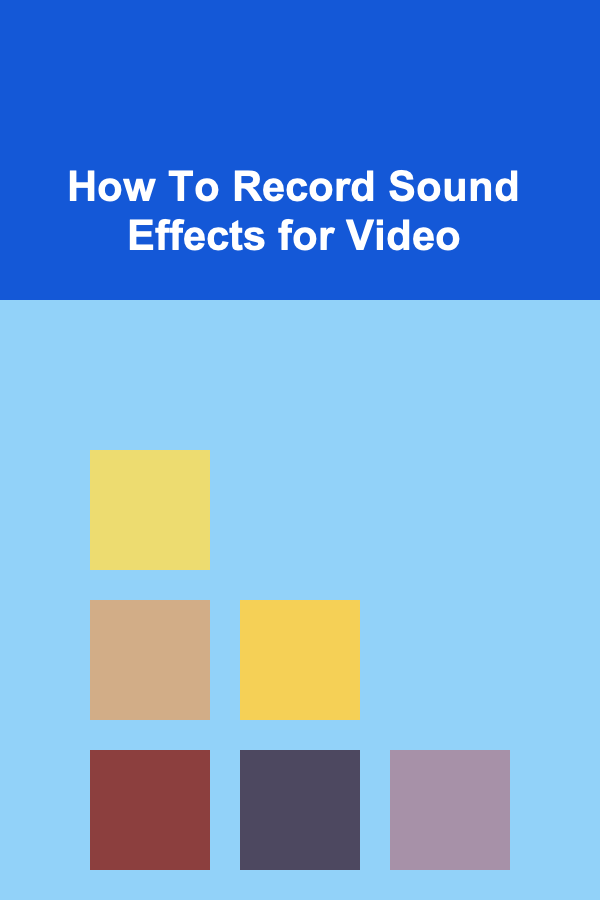
How To Record Sound Effects for Video
ebook include PDF & Audio bundle (Micro Guide)
$12.99$9.99
Limited Time Offer! Order within the next:

Recording sound effects for video is a crucial aspect of the filmmaking process. Sound enhances the visual experience, creating an emotional connection between the audience and the scenes. It is not enough to simply capture dialogue or background noise; the sounds that accompany actions, movements, and specific scenarios contribute to the overall atmosphere and realism. Whether you're an amateur filmmaker, a hobbyist, or a professional sound designer, learning how to properly record sound effects is an essential skill.
In this article, we will explore the various techniques and tools involved in recording sound effects for video. From understanding the importance of sound effects to the detailed process of capturing, editing, and integrating these sounds into your video, this guide will provide a comprehensive approach to sound effect recording.
The Importance of Sound Effects in Video
Sound effects play an essential role in enhancing the narrative of a video. While visuals provide the framework for storytelling, sound gives the story texture and depth. Here's why sound effects matter:
1.1 Creating Realism
One of the primary functions of sound effects is to create a sense of realism. Whether it's the sound of footsteps on gravel, the rustling of leaves, or the distant hum of a machine, sound helps ground the viewer in the world you're depicting. If the sound is missing or doesn't match the action on screen, it can break the immersion and take the audience out of the experience.
1.2 Setting the Tone and Mood
Sound effects are integral in establishing the tone of a scene. For example, eerie, unsettling noises can heighten tension in a horror movie, while upbeat, fast-paced sounds can energize an action sequence. These sounds can dictate the emotional state of the viewer, guiding them to react in a particular way. Without effective sound effects, a video might lack emotional depth.
1.3 Enhancing the Story
Good sound design amplifies storytelling. For instance, subtle background sounds can reveal important details about the setting. A creaking door might suggest an old, abandoned house, while the clinking of glass can indicate a busy bar scene. Additionally, specific sound effects tied to a character or action can help the viewer follow the plot more effectively.
Preparing for Sound Recording
Before you start recording sound effects, preparation is key. The process involves not only choosing the right equipment but also planning the sounds you need and understanding the technical aspects of sound recording.
2.1 Equipment for Sound Recording
Sound effects recording requires specialized equipment to ensure the best results. Here are the essential tools for capturing high-quality sound:
-
Microphones: The choice of microphone can significantly affect the quality of the recording. For sound effects, you'll want microphones that capture a wide range of frequencies and nuances. Popular choices include:
- Shotgun microphones: Great for capturing directional sound from a distance.
- Lavalier microphones: Small, clip-on microphones that can be used to capture specific sounds.
- Contact microphones: These are useful for recording vibrations, ideal for capturing the sound of objects like tapping, scraping, or rustling.
- Stereo microphones: These provide a richer sound by capturing sound in stereo, useful for environmental recordings.
-
Audio Recorder: A portable audio recorder is essential for capturing sound effects on location. Popular models include the Zoom H5 and H6, as well as the Tascam DR-40X. Make sure the recorder supports high-quality audio formats, such as WAV or AIFF.
-
Boom Poles and Windshields: If you're recording outdoors or in noisy environments, using a boom pole with a windshield (also known as a dead cat) will help reduce wind noise and ensure clearer sound.
-
Headphones: High-quality headphones are crucial for monitoring your recordings in real-time. This helps ensure that the sounds are captured properly and that unwanted noise is minimized.
-
Portable Soundproofing Tools: When recording in a less-than-ideal environment, consider bringing soundproofing materials like foam panels or blankets to reduce unwanted ambient noise.
2.2 Sound Library and Planning
Before heading out to record, it's essential to plan the sounds you need. A sound library is a valuable tool, especially for commonly used sounds like footsteps, door creaks, or ambient city noise. Some filmmakers choose to record everything themselves, while others use pre-recorded sound libraries to save time.
If you're going to record your own sound effects, start by making a list of the sounds you need for your video. For example:
- Footsteps: Different surfaces (gravel, wood, tiles)
- Doors: Opening, closing, squeaking
- Environmental sounds: Wind, rain, birds, distant traffic
- Specific actions: Gunshots, punches, explosions
Being organized will help you avoid missing essential sound effects while recording.
Recording Techniques
With the proper equipment and a clear plan, you can begin recording your sound effects. The techniques you use to capture sound will influence how well it fits into your video. Below are some tips to help you get the best results:
3.1 Direct Recording vs. Field Recording
There are two primary approaches to recording sound effects: direct recording and field recording.
- Direct Recording: This involves recording sound effects in a controlled environment, typically in a studio. You can use tools like contact microphones and specialized sound-recording equipment to capture clean, direct sounds. This method is ideal for controlled, predictable sounds like objects being struck, doors closing, or footsteps.
- Field Recording: Field recording involves capturing sounds in natural environments. This is essential for environmental sounds like wind, birdsong, or distant chatter. Field recording is more unpredictable, and you must consider factors such as weather, background noise, and acoustics.
Both techniques have their advantages and disadvantages, and often, sound designers will use a combination of the two to create a layered soundscape.
3.2 Using the Right Distance
The distance between your microphone and the sound source will affect the recording quality. For most sound effects, you want to be close to the sound source to capture the nuances. However, certain sounds, such as ambient noises or environmental recordings, require a greater distance to capture the full soundscape.
Experiment with distances to see what works best for each sound. For example, for footsteps on gravel, try recording from a distance of 3-5 feet, while for something like a gunshot or an explosion, you'll want to be much further away.
3.3 Layering Sounds for Depth
One of the secrets to great sound design is layering. Instead of relying on a single sound for a scene, you can combine multiple recordings to create a more dynamic and engaging result. For instance, for a car passing by, you could layer sounds such as:
- The car engine
- Tires on asphalt
- Distant traffic
- Wind or environmental sounds
By layering these recordings, you create a more realistic and immersive soundscape.
3.4 Using Props for Sound Effects
Sometimes, everyday objects can be used to create high-quality sound effects. Here are a few examples of common props that can mimic realistic sounds:
- Rustling leaves: Try using a plastic bag or a bundle of dry leaves.
- Creaking wood: Bend a piece of cardboard or wood.
- Glass shattering: Use a glass bottle or breakable material for controlled destruction.
- Footsteps: Use different surfaces like gravel, wood, and sandpaper to mimic different terrains.
Props like these can help you achieve more authentic sound effects without needing expensive equipment.
Editing Sound Effects
Once you have recorded your sound effects, the next step is editing them. Good sound editing can make the difference between an amateur-sounding recording and a professional-quality track.
4.1 Choosing the Right Software
The software you use will determine how effectively you can edit and manipulate your sound effects. Some popular digital audio workstations (DAWs) for sound editing include:
- Adobe Audition: A comprehensive, professional audio editing software with advanced features for sound design.
- Pro Tools: The industry standard for audio recording and editing, offering an array of tools for precise sound manipulation.
- Audacity: A free, open-source DAW suitable for basic sound editing tasks, ideal for beginners.
Choose the software that suits your needs and experience level.
4.2 Editing Techniques
When editing your sound effects, here are a few techniques to consider:
- Cleaning Up Noises: Use noise reduction tools to remove any unwanted background sounds, like hum or static. These tools can automatically analyze and remove consistent noises.
- Equalization (EQ): EQ allows you to adjust the balance of frequencies in your sound, emphasizing certain elements while reducing others.
- Compression: Use compression to even out the volume levels and ensure that no part of the sound is too quiet or too loud.
- Time Stretching: This allows you to change the duration of the sound without altering its pitch, which can be useful for syncing sound effects with video.
- Reverb and Echo: Adding reverb or echo effects can help your sound blend better with the environment of the video, simulating acoustics and distance.
4.3 Syncing Sound with Video
Once you've edited your sound effects, the final step is to sync them with the video. This requires precision, as the sound must match the actions on screen. You can do this by:
- Importing both the sound effects and the video into a video editing software.
- Aligning the sound effects with the corresponding actions in the video.
- Adjusting the timing and levels of each sound to ensure they fit seamlessly.
4.4 Mixing and Mastering
Mixing involves adjusting the balance of all the sound elements in your video, including dialogue, music, and sound effects. You can use panning, volume levels, and EQ to ensure that each sound serves its purpose and doesn't overwhelm others.
Mastering is the final step in preparing your audio for distribution. This involves ensuring that the sound is consistent across different playback systems and optimizing the overall audio for clarity and quality.
Conclusion
Recording sound effects for video is a meticulous but rewarding process. It involves understanding the importance of sound, preparing the necessary equipment, and applying various techniques to capture, edit, and integrate sound into your video project. Whether you're working on a short film, a commercial, or a YouTube video, mastering the art of sound effect recording will elevate your production quality and bring your vision to life.
By paying attention to detail, using the right tools, and experimenting with different techniques, you can create immersive soundscapes that enhance the storytelling and captivate your audience.

How to Choose the Right Rugs for an Organized Living Room
Read More
How to Use Magnetic Recipe Holders for Space-Saving
Read More
Unlocking Passive Income with Deep Learning
Read More
Why Using Color Coding Makes Organization Fun
Read More
Exploring the Principles of Naturopathic Medicine: A Comprehensive Guide
Read More
Exploring Machu Picchu: A Deep Dive into the Lost City
Read MoreOther Products

How to Choose the Right Rugs for an Organized Living Room
Read More
How to Use Magnetic Recipe Holders for Space-Saving
Read More
Unlocking Passive Income with Deep Learning
Read More
Why Using Color Coding Makes Organization Fun
Read More
Exploring the Principles of Naturopathic Medicine: A Comprehensive Guide
Read More